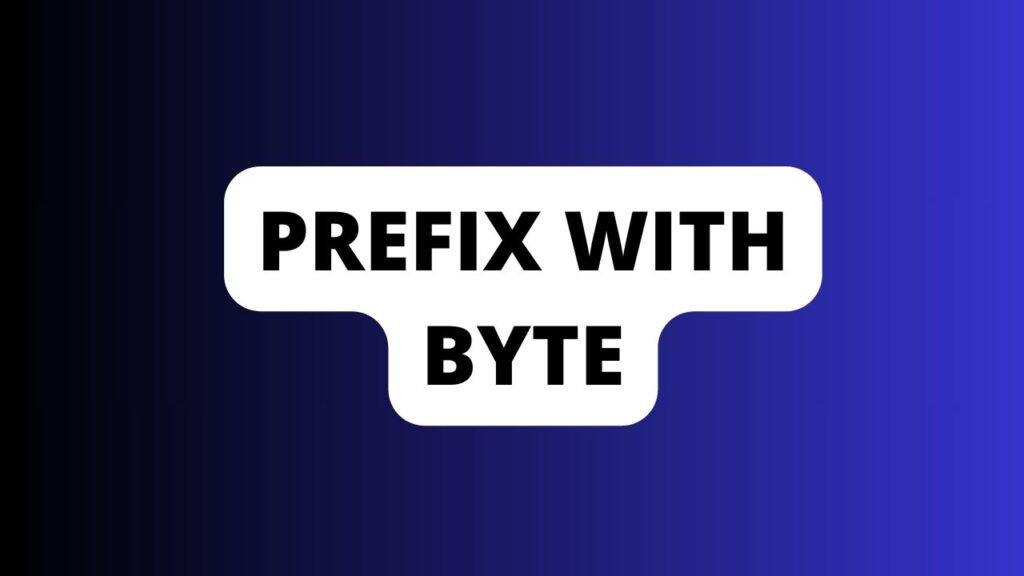Introduction
What is a prefix with byte? Understanding this concept is crucial in navigating the intricacies of data management. In computing, a prefix refers to an affix added before the base unit to denote multiples or submultiples. When combined with ‘byte,’ these prefixes play a vital role in defining data sizes.
Introducing Prefix With Byte
Prefix With Byte: Unveiling the Paradigm Shift
Prefix With Byte introduces a paradigm shift in data processing methodologies. Harnessing advanced algorithms and machine learning capabilities, it optimizes data workflows, offering unparalleled speed, scalability, and security.
How Prefix With Byte Works
At its core, Prefix With Byte employs an innovative algorithm that efficiently preprocesses data, enhancing processing speeds significantly. Its adaptive architecture seamlessly accommodates varying data volumes and complexities, ensuring swift and accurate processing.
Understanding Prefixes
Various types of prefixes with bytes exist, each indicating a different quantity of bytes. These prefixes, such as kilo, mega, giga, and tera, denote multiples of bytes. They facilitate the representation of vast data quantities in a comprehensible manner.
Significance
Prefixes significantly impact data storage. They enable the categorization and organization of massive amounts of data into manageable units, enhancing accessibility and comprehension.
Importance in Computing
In the realm of computing, prefixes with bytes are foundational. They establish the framework for data representation, influencing storage methodologies and computational operations.
Prefix with Byte Application
The real-world applications of prefixes with bytes are diverse. From memory allocation in computer systems to measuring file sizes, these prefixes find extensive use in various technological domains.
How to Define a Prefix
Understanding the characteristics and definition of prefixes is fundamental. They modify the value of the base unit, allowing for easier interpretation of data sizes.

Common Prefix Examples
Examples of prefixes used with bytes include kilobyte, megabyte, gigabyte, and terabyte. Each denotes a specific quantity, aiding in data measurement and comprehension.
Advantages
The utilization of prefixes with bytes brings numerous benefits. It facilitates easy comprehension of data sizes and streamlines data management processes.
Disadvantages
However, there are limitations to the use of prefixes with bytes. These include potential confusion with decimal and binary interpretations, impacting accuracy in certain contexts.
Prefix and Efficiency
The efficiency impact of prefixes in byte context is substantial. They enable data to be categorized and managed efficiently, optimizing storage and retrieval processes.
Future of Prefixes
The evolution of prefixes with bytes continues to shape the technological landscape. Innovations in data management continually redefine their applications and significance.
Prefix and Data Management
Efficient data management involves leveraging prefixes effectively. Implementing them optimally contributes to streamlined data organization and access.
Prefix Challenges
Implementing prefixes with bytes presents challenges, such as standardization and compatibility issues across systems, requiring meticulous consideration.
Conclusion
In conclusion, understanding and leveraging prefixes with bytes are integral to effective data management in modern computing. These entities simplify data representation and organization, despite their inherent complexities.
FAQs
- How do prefixes impact data storage? Prefixes categorize and organize data into manageable units, simplifying storage and retrieval processes.
- What are the common examples of prefixes used with bytes? Common examples include kilobyte, megabyte, gigabyte, and terabyte, denoting varying quantities of bytes.
- Are there limitations to using prefixes with bytes? Yes, limitations exist, particularly in contexts involving decimal and binary interpretations, potentially impacting accuracy.
- What role do prefixes play in future data management? The evolution of prefixes continues to shape data management, contributing to more efficient and innovative solutions.
- How can prefixes be effectively implemented in data systems? Effective implementation requires standardization and compatibility considerations across systems for seamless integration.
- Are there specific challenges associated with implementing prefixes in data management? Challenges include ensuring uniformity and compatibility across diverse systems, demanding meticulous planning and execution.
